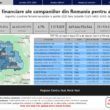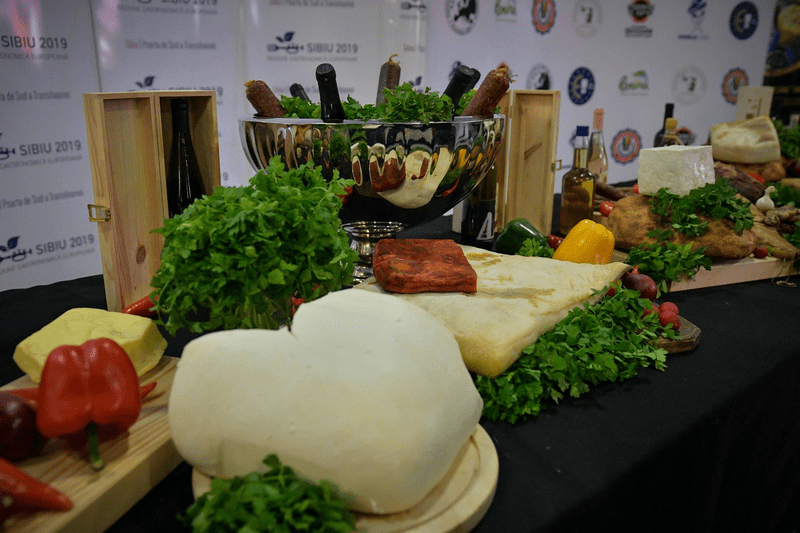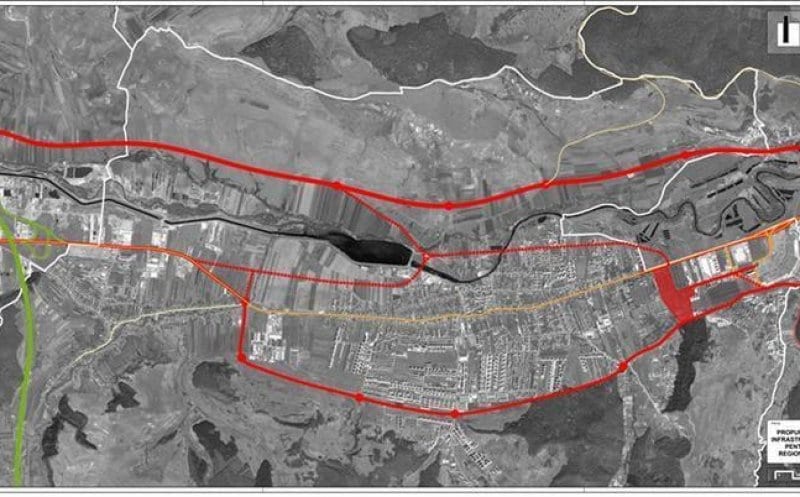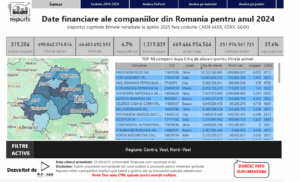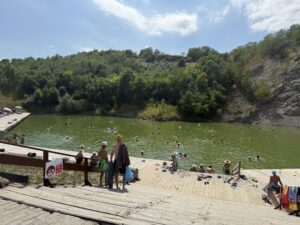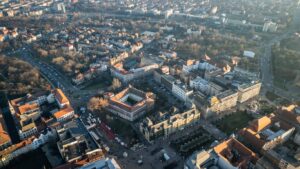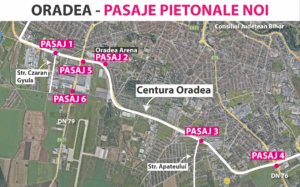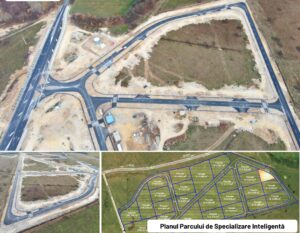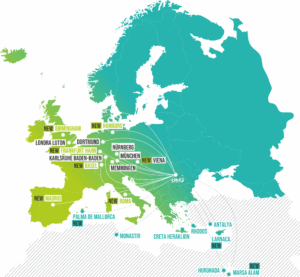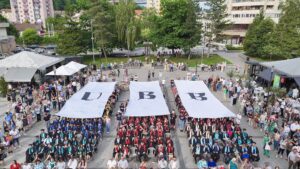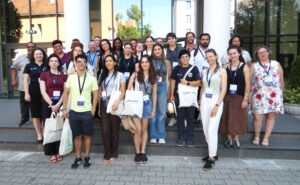The town of Sibiu puts on a gastronomical show in 2019. With a display of traditional recipes that have been carefully preserved and passed on for generations, based on clean ingredients from local farmers, Sibiu, also known as the Southern Gate of Transylvania, is getting ready to share its’ unmistakeable flavour with the rest of the world.

The Region of Sibiu (Romania) was awarded the title of European Region of Gastronomy in 2019 by the International Institute of Gastronomy, Culture, Arts and Tourism. The region’s application received a positive review and the jury’s visit to Transylvania was proof enough that Sibiu and Romania have what to show the world in terms of culinary art. The programme is run by a consortium made of the Sibiu County Council, the Sibiu City Hall, the Mediaș City Hall, the Sibiu Chamber of Commerce, Industry and Agriculture, the “Lucian Blaga” University in Sibiu and the Sibiu County Tourism Association, with a seventh member joining this year: the “Nicolae Bălcescu” Land Forces Academy. This important title of European Region of Gastronomy is shared together with the South Aegean Region (Greece), and was passed on/carried forward by/from the previous holders – Galway-West of Ireland (Ireland) and North Brabant (Holland), during an official ceremony. Diane Dodd, Chairman of the International Institute of Gastronomy, Culture, Arts and Tourism, encouraged the local authorities to fully benefit from this programme.
‘I have seen increasing interest in maintaining cultural diversity and finding solutions to the challenges posed by globalisation. I have seen innovation and creativity, fantastic menus, and I have tasted fabulous dishes in Sibiu. I believe that winning the title of European Region of Gastronomy brings along three huge advantages: the credibility that comes with holding this distinction, the international visibility and, most importantly, I believe, the fact that this honour brings people together for a common purpose and a common value. Uniting as many people as possible for the same direction is the most beautiful thing one can achieve’, said Diane Dodd.
President of Romania: “It is a project… to my taste”
Ever since his debut, Romanian President Klaus Iohannis, who’s family is from Sibiu, praised the European Region of Gastronomy programme and reasserted Sibiu’s ability to carry out large scale European projects.
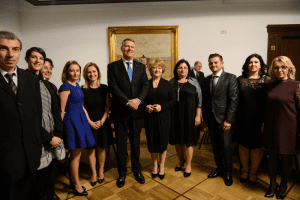
“Sibiu – European Region of Gastronomy is an event…to my taste! I congratulate everyone who has been involved and who has believed that Sibiu has the potential for more. I deeply appreciate how you turned a small-scale project into a partnership between so many local actors and succeeded in promoting the region of Sibiu. This regional approach is authentically European and I am convinced it will be a huge success. But there is also another reason: the food from the Sibiu and Mărginime area[i] is the best”, said the Romanian President during the official launching of the programme.
The significance of the European Region of Gastronomy
Only eight regions in Europe have had the privilege of being awarded this special distinction so far, among which Catalonia (Spain) and Lombardy (Italy). Sibiu owes this title to the local culinary traditions that have been well preserved throughout the region, but also to the diverse cultural influences in the area. The award not only benefits the whole surroundings of Sibiu but also the entire country, as all of Romania is worth being discovered and valued for its traditional food, local produce, unique natural scenery and the concern for a healthy diet.
The title of European Region of Gastronomy is of great significance for small and medium farmers in the rural area, because it encourages the production of food based on ecologically grown ingredients, following centuries-old traditions. This year more than ever, these products are at the heart of dozens of projects and events aimed at celebrating local flavour and healthy food.
Gastronomy events
Whether preparing for presidents, diplomats, or tourists at over 2,000 metres altitude, the cooks in the European Region of Gastronomy programme have managed to synchronise each other perfectly every time and prepare the right dishes, in the purest respect for tradition – with a bit of added creativity.
A successful preview to the 2019 Sibiu – European Region of Gastronomy started in 2018, through the cultural events organised by the Sibiu County Council and the Sibiu and Mediaș City Hall, all of which contained some sort of culinary ‘happening’. The consortium organised several events with local and partner funding, of which the most important was the programme launch programme in Bucharest, in the presence of the President of Romania, the diplomatic corps, various officials and the national and local press.
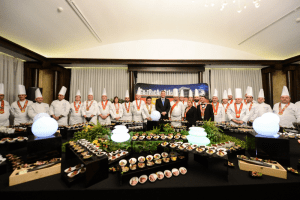
The programme has already organised several events this year, the ‘Winter tastes’, during which hundreds of people were able to exhibit and sell traditional preparations, take part in original competitions: making sausages, slănină[ii] or matured cheeses, as well as compete in international championships of pizza and pasta cooking. Some of the events included cooking in the open, such as pastoral cooking. Curious tourists were able to taste sheep stuffed cabbage, sheep sloi[iii], spicy sheep stew, mutton[iv] broth with tarragon and cream, cauldron polenta, cauldron balmoș[v] and mutton on a spit. Some of the most spectacular dishes were the sheep or Black Angus roasts on a spit.
The taste of Sibiu in spring
Almost 60 restaurants from the region of Sibiu took part in “Tastes of Sibiu”, each preparing their own five-item menu, some of which specifically designed for the European Region of Gastronomy programme, others inspired from the area’s culinary traditions. The special menu was included in the regular one in all the restaurants that accepted to be part of the programme. Soon, the spring edition will be out, featuring fresh vegetables and tender meat. You will be sure to find Transylvanian or Saxon broths, jumări paste, pork stew, grilled lamb from the Mărginime region, mountain trout, venison cutlets, ricotta pancakes, garden apple strudel, Cisnădie pound cake and the list goes on. The preparations are provided by the small local producers. The organisers have also prepared a brochure featuring all the restaurants and their goodies, as well as a list of beer and wine manufacturers in Sibiu.
May highlights
The Rural Community Fair will take place for the first time this year on the 18th May. Crafts, music, dance and gastronomy will be intertwined, and the Museum Night will be a good opportunity to organise a culinary marathon featuring old Sibiu recipes, interactive workshops and traditional food tasting. Everyone is invited on 19 May to discover the region known as “Țara Secașelor” and visit its museum in Miercurea Sibiului, where tourists can enjoy a mixture of gastronomy and viticulture.
Sibiu products, promoted in Vienna and Berlin
The European Region of Gastronomy programme has been promoted through a range of international events. The consortium took part in the Berlin International Tourism and Trade Fair. Hundreds of visitors had the chance of tasting cheeses and salamis, cured fatback and smoked meat products, vegetables, Transylvanian bread and traditional sweetmeats. The products from Sibiu were also displayed at the Romanian Embassy in Berlin, as part of the exhibition called “Two Regions in Europe – the Centru Region and the Brandenburg Land”, inaugurated by Emil Hurezeanu, His Excellency the Ambassador of Romania to Germany. The event was included in the working visit for Implementing Smart Specialisation Strategies, which reunited representatives of the administrative units from the Centru Region and of the Regional Development Agency – Centru. Each county belonging to the Centru Region was invited to prepare a presentation stand with its local products. Sibiu chose the 2019 European Region of Gastronomy programme as the main theme for its exhibition.
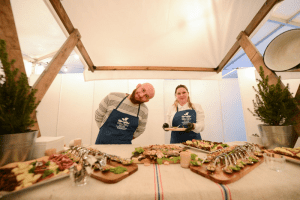
Moreover, the Embassy of Romania in Vienna recently hosted an event for promoting the Sibiu – European Region of Gastronomy in 2019 programme. More than one hundred guests from a variety of fields attended the event organised by His Excellency the Ambassador Bogdan Mazuru, among which: representatives of the diplomatic core in Vienna, delegates of the Austrian authorities, members of the academic community in Vienna, businessmen and journalists. The Mayor of Sibiu, Mrs. Astrid Fodor, was also present as a representative of the Town of Sibiu, one of the members of the Consortium managing the Sibiu – European Region of Gastronomy in 2019 programme. Some of the other guests from Sibiu who presented the Romanian culinary traditions to the public included delegates of the County Council, the County Tourism Association and representatives of the food service industry.
Dishes to be proud of in Sibiu
Dairy
Cheese products are an important part of the culinary and cultural traditions of the province, depending on a variety of factors ranging from the altitude of the pasture to the method used to produce them. For instance, in the region of Mărginimea Sibiului, with upland pastures, the old tradition for producing the “telemea”[vi] cheese has been preserved to this day, so has the recipe for “lapte gros”[vii], “brânză de burduf”[viii], fermented cheese or “urdă”[ix]. In the 18th and 19th century shepherds roamed as far as Crimea during the transhumance period, but today most of them have settled in Banat and Dobrogea, while some of them are practicing local shepherding in the Cibin Mountains. Tourists are invited to take part in all sorts of events in the Mărginime area and discover all these beautiful traditions. Some of the ones worth mentioning are: the July fest “Sus pe muntele din Jina”, the shepherds’ celebration in Tilișca in August, known as “Sărbătoarea oierilor”, or the gathering of the sheep festivity called “Coborâtul oilor”, in September.
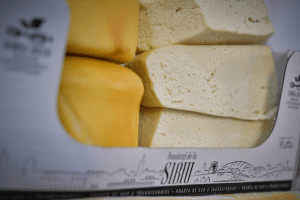
Fun fact! (can be inserted in the text) „In Saxon villages, buffalo and goat milk are often used in cheese preparations to give them a special flavour”.
Salamis
Cold winters in the mountains call for a diet rich in protein and fat. Shepherds from Sibiu are known to indulge in such foods, accompanied by “a teeny bit of strong plum brandy”. It all starts with the Ignat ritual of sacrificing a pig, on 20 December. The practice is the same today as it was centuries ago and ends with a thanksgiving meal called “pomana porcului” (the commemoration of the pig). Nothing is thrown away and every part of the sacrificed animal is used to produce traditional recipes that have been handed down for generations: “caltaboş” (pork haggis), sausages, “tobă” (a variety of blood sausage), “piftie” (meat jelly), “jumări” (pork cracklins), canned pork in lard, salted “șorici” (pork rind); or ribs cooked with a variety of spices that go well with pork, such as thyme, pepper, tarragon, coriander, allspice or sweet paprika. A very special preparation is the salted and smoked fatback, which Saxons used to store in the bell tower. The locals of Mărginime use birch wood to smoke the fatback, then hang it up on a hook to dry.
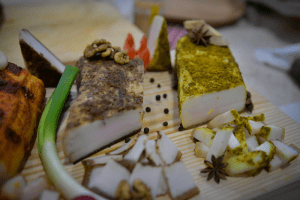
Fun fact: „A typical delicacy is the “chisătură”: fatback paste finely chopped and mixed with parsley and onion. Guaranteed to mouth-water if spread on a large slice of bread. Also, don’t miss out on the Sibiu paté, a traditional gourmet food that has been around for over 90 years.
Bread
For many of us, the taste of wood-fired countryside bread is merely a beautiful memory from our childhood. However, there are still quite a few hardworking people who wake up before the sun rises to put the dough in the oven to bake. People in Sibiu prefer the sweeter varieties of bread, such as potato, linseed, pumpkin or sunflower seed bread. The loaves are generally round and big, weighing 1 kg, enough to feed the whole family.
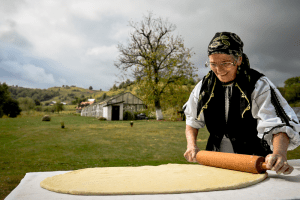
Fun fact: In Şura Mică, Str. Principală nr. 99, you can buy traditional cake “by the meter”, following an old Saxon recipe.
Beverages
Orchards, specifically apple and plum tree, can be seen in many places in the province, due to the sunny terraced hillsides and the rich soil. Nutritious fruit juices produced locally are widely appreciated, such as the Slimnic or Mălâncrav natural apple juice.
Fun fact: Try natural syrups made of forest fruits, buckthorn, pine buds or elder flower, and add a drop of honey, just like in the old days.
Wine
The best known wine from the region is the Apold wine, whose name is closely linked to the Saxons, but whose tradition has been carried on by Romanians. The vineyard of Apold is in the western part of the Sibiu County and is one of the best wine-growing lands in the country. Viticulture has been a tradition here since old times. The Landlers, a Germanic population, understood the importance of the local climate and the terraced land for wine-growing and kept the tradition going. Over the last decades, the land has been used to produce mostly sparkling wine.
Italian Riesling, Pinot Grigio, Muscat Ottonel, Traminer Aromatico, Sauvignon Blanc are a few of the varieties that can be found on the new plantations, with a total surface of 62 hectares. The Gorgandin wines have a very long-standing history and the name is derived from the hill on which the vineyard is grown.
Sweetmeats
Romanians, Saxons and Hungarians living together for centuries in the region of Sibiu have contributed largely to the diversity of culinary recipes, and sweets are among the best proof of that. Wherever you go, people are likely to welcome you with home-made preparations based on recipes inherited from their grandmother. There is quite a rich offer to choose from: “hencleş” (traditional Saxon cake made with eggs, fruit and cream), fruit cakes, cookies with jam or honey, sweet and sour rhubarb cake, plum pie, cabbage or onion pie, or pancakes stuffed with “urdă” and dill.
Fun fact: rosehip jam (which the Saxons call Hetschenpetsch) was initially produced by the Saxons living in the Sibiu surroundings. To make it, you need to turn the fruit into a paste by separating the flesh from the seeds and cooking it. The paste is then passed through a sieve and cooked again in a traditional oven.
Astrid Fodor, the Mayor of Sibiu
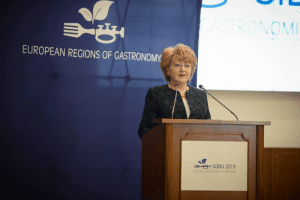
„The Sibiu – European Region of Gastronomy programme is a solid instrument that will help us boost the development of our city. One of the core objectives of the programme is to preserve and highlight our gastronomical traditions, which are the result of an ethnic and cultural diversity that makes our region special. A second important objective is to offer local producers the possibility to grow and promote the products so typical of this region, and give them access to a more generous market in the local food service industry. The educational aspect of the programme is also very important, as we will do our best to teach the public to rediscover the healthy food that Sibiu has to offer in abundance.”
Daniela Câmpean, President of the Sibiu County Council
“We are happy that Sibiu has been awarded the tile of European Region of Gastronomy at the same time with so many other important events: the Centenary of the Great Union, the Romanian Presidency of the Council of the European Union, as well as the Informal European Council Summit in Sibiu which puts our town and province on the map of places that have hosted crucial events for the future of Europe. Romania and Romanians alike reassert their support for the European project, and events such as these give us the opportunity to prove that dialogue, diversity and multiculturalism, tolerance and peaceful cohabitation are values we adhere to.
The Southern Gate of Transylvania
Transylvania, or the “Ardeal” is also referred to as the “land beyond the forest” or the country beyond the forests. The name place is derived from medieval Latin, officially mentioned in a historical document from 1075 CE (“terra ultra silvam”), ultra meaning „beyond” or „on the far side of” and the accusative case of sylva (sylvam) meaning „woods, forest”. The fertile soil, beautiful wild nature and man-built constructions, the spirituality and hospitability of Transylvanians are the key elements that have helped shape the reputation of this land over the centuries.
South of this region is the county of Sibiu, rich in resources and with a variety of landscapes such as the Făgăraș, Cindrel or Lotru mountains, the Târnave plateau, the Hârtibaciului and Secașelor highlands, the Olt, Târnava Mare and Cibin rivers, and home to 464,305 Romanian, Saxons, Hungarians and other ethnical groups. Livestock breeding and farming are to this day the main activities in the countryside.
The region of Sibiu, in numbers
88 certified ecological producers.
175 restaurants.
11 traditional products from 3 certified manufactures.
7 products with a certified recipe from 3 producers.
1 – Protected Geographical Indication (Sibiu Salami).
464,305 inhabitants.
County surface of 5,432 sqm.
304,849 hectares of arable surface.
[i] Mărginimea Sibiului is a geographical area comprised of 18 towns in the south-western part of the Sibiu County in Transylvania, Romania, with a rich ethnic, cultural, architectural and historical heritage (Wikipedia).
[ii] Slănină, also referred to as salo in Ukrainian and Russian, or szalonna in Hungarian, and slonina in Polish, is a traditional, predominantly Slavic food consisting of cured slabs of fatback (rarely pork belly), with or without skin. The food is commonly eaten and known under different names in countries across the region. It is usually dry salt or brine cured. The East Slavic variety is sometimes treated with paprika or other seasonings, while the South Slavic version is often smoked (Wikipedia).
[iii] Sloi – meat preparation made of sheep’s meat cooked with herbs, spices, onion and peppers until the meat falls off the bones, then let to cool and harden into a solid block. Usually stored and eaten over winter.
[iv] Mutton – the meat of a castrated male (wether) sheep having more than two permanent incisors in wear (Wikipedia).
[v] Balmoș – a type of polenta made of maize flour cooked in whey and typically served with cream or onion.
[vi] Telemea – a soft, white sheep’s milk cheese with a creamy texture and tangy aftertaste, similar in taste to Feta. Used in salads and in pairings with snacks. Typically stored in a brine solution, which makes it get saltier with age (www.cheese.com).
[vii] Lapte gros – a type of fermented milk, or yoghurt.
[viii] Brânză de burduf – soft sheep’s milk cheese produced from sheep’s raw milk cut into small pieces, salted and then hand-mixed in a large wooden bowl, and then left to age inside fir tree bark between 20 and 90 days. The longer the period of aging, the spicier and saltier the cheese becomes. It is typically produced from May to July when the fir tree bark is rich in aromatic resin (www.cheese.com).
[ix] Urdă – a type of traditional whey cheese whose is similar to that of making Ricotta. The paste is grainy, silky and pleasant to taste. In Romanian cooking, Urdă is often used to make desserts (www.cheese.com).
By Irina PAPUC
Photo: sibiu.ro
Articol publicat în ediția de colecție a revistei Transilvania Business – Enjoy Transylvania! A jewel of Romania at the heart of Europe, ediție distribuită, cu sprijinul Primăriei Municipiului Sibiu, la Consiliul European informal de la Sibiu – 9 mai 2019

